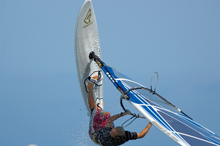(FULL WOOD SANDWICH) Despite being considerably shorter and quoting only one litre more in volume, the Real WorldWave (RWW) 74 is clearly quite a lot bigger than the ProWave 73 also tested here. It’s the ‘stubby’ shape of the two ranges. Last year (’07) JP made the RWW 76 quite a bit smaller than the ’06 equivalent. This year (’08) they have kept it similar or maybe a fraction bigger in size but nominally dropped it a couple of litres. The main change from last year is in the rockerline with this year’s board breaking with the moderate (or fast) rocker of the past, to bemuchmore in line with average to higher waveboard rockerlines.
On the Water:
The effect of the increased rocker can certainly be felt in the early planing, which is now fairly average for a waveboard rather than clearly better than average as in previous years. However, the wide tail and overall width means that the board sits quite high in the water thus lifting quite progressively onto the plane rather than needing to be unstuck. The RWW was one of the easiest boards in the test to just sail. It needs to be borne off the wind to get going but thereafter it tracks well and is both very stable and yet controlled for its size. It is one of the most well behaved, compact and comfortable boards on all points of sailing, and feels quite neutral in the sense that it’s neither excessively loose and slidey or particularly grippy. It gybes nicely though tends to slow when coming out if not driven hard through the exit. It is a very easy board to set up and turn on a wave and, although it doesn’t redirect quite as well as the best, it is versatile in having the width and enough slide to give good onshore riding without being too technical. The increased rocker means that it now copes with slightly higher boardspeeds for better riding in strongerwinds and biggerwaves, but doesn’t have quite the same flow in moderate onshore as the boards of the previous two years. It offers good control but is a big board and does start to become a bit bouncy for average weight sailors in stronger winds.
Fittings: In the past we have been able to improve the performance of JP waveboards by replacing their moulded fins, but this year the fin seemed to perform reasonably anyway. The straps and deckpads were of the usual excellent standard.
Popularity:
High. Of the six guesters and testers who sailed all, or nearly all, of the boards the JP RWWnever dropped below sixth place in the rankings.This was due mainly to its being at once comfortable, easy and relatively all-round in performance.
Overall:
Those who think of the RWWs as fast waveboards verging towards freestyle-waves should now change that view. They don’t offer the same moderate wind performance of old but they have gained a bit more control in stronger winds and can handle slightly faster boardspeeds on a wave. Overall, the RWW 74 is quite a large but very comfortable and versatile all-round waveboard that was justly popular and would be ideal for much UK coastal sailing.





